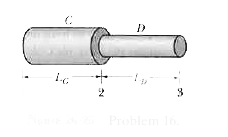Wire C and wire D are made from different materials and have length LC=LD=1.0m. The resistivity and radius of wire C are 2.0×10−6.Ωm and 1.00 mm, and those of wire D are 1.0×1.0−6Ω.m. and 0.50 mm. The wires are joined as shown in Fig. 26-25, and a current of 2.0 A is set up in them. What is the electric potential difference between a) points 1 and 2 and (b) points 2 and 3? What is the rate at which energy is dissipated between c) points 1 and 2 and (d) points 2 and 3? 
The correct Answer is:(a) 1.3 V; (b) 2.546≈2.5V;(c)2.5W;(d)5.1W
Topper's Solved these Questions
- CURRENT AND RESISTANCEBook:RESNICK AND HALLIDAYChapter:CURRENT AND RESISTANCEExercise:Practice Questions (Single Corret Choice Type)
Explore 39 Videos
- CURRENT AND RESISTANCEBook:RESNICK AND HALLIDAYChapter:CURRENT AND RESISTANCEExercise:Practice Questions (Linked Comprehension)
Explore 5 Videos
- CURRENT AND RESISTANCEBook:RESNICK AND HALLIDAYChapter:CURRENT AND RESISTANCEExercise:Checkpoints
Explore 6 Videos
- CIRCULAR MOTIONBook:RESNICK AND HALLIDAYChapter:CIRCULAR MOTIONExercise:CHECK POINTS
Explore 6 Videos
- ELASTICITYBook:RESNICK AND HALLIDAYChapter:ELASTICITYExercise:PRACTICE QUESTIONS (Integer Type)
Explore 3 Videos
Similar Questions
The resistivity of a potentiometer wire is 40×10−8Ω−m and its area of cross section is 8×10−6m2. If 0.2 A current is flowing through the wire the potential gradient will be
View SolutionIf the length of wire is (100.0 cm) and radius of wire as measured from screw gauge is (1.00mm) then the specific resistance of wire material is .
View Solution
Knowledge Check
The resistance of a wire of length 330m and cross-section area 1.0mm2 made of material of resistivity 1.0×10−7Ωm is:
A2ΩB3ΩC20ΩD3ΩThe resistance of a wire is 5Ω at 50∘C and 6Ω at 100∘C . The resistance of the wire at 0∘C will be
A3ΩB2ΩC1ΩD4ΩThe resistivity of a potentiometer wire is 40×10−8Ω−m and its area of cross section is 8×10−6m2. If 0.2 A current is flowing through the wire the potential gradient will be
A10−2VmB10−1VmC3.2×10−2VmD1Vm
Resistivity of a material of wire is 3⋅10−6Ω−m and resistance of a particular thickness and length of wire is 2Ω. If the diameter of the wire gets doubled then the resistivity will be
View SolutionWhat is the length of a wire of radius 0.2 mm and resitance 25Ω? The restivity of the material of the wire is 2π×10−8Ω.m.
View SolutionThe specific resistance of a potentiometer wire is 10−7Ωm and the cross sectional area of the wire is 10−6m2. If a current of 0.1 A flows through the wire, then the potential gradient will be
View SolutionIf the length of wire is (100.0 cm) and radius of wire as measured from screw gauge is (1.00mm) then the specific resistance of wire material is .
View SolutionResistivity of a material of wire is 3⋅10−6Ω−m and resistance of a particular thickness and length of wire is 2Ω. If the diameter of the wire gets doubled then the resistivity will be
View Solution

